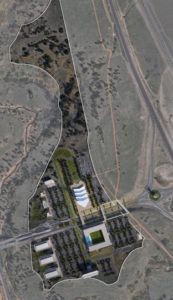COLORADO SPRINGS–The El Paso Board of County Commissioners got a look at the U.S. Air Force Academy (AFA) visitor’s center project Tuesday during an urban renewal authority work session at Centennial Hall, where among other things, commissioners questioned the use of tax subsidies for the project.
The True North Commons project, an element in Colorado Springs Mayor John Suthers’ City for Champions (C4C) plan, was presented by Blue and Silver Development Partners president Daniel Schnepf.
The plan includes some 350 hotel rooms in three separate but connected buildings with varying levels of service and room costs. A four-star hotel will dominate the complex and a three-star hotel will offer more affordable room rates. One part of the hotel complex will be specifically for visiting military personnel and will have room rates consistent with federal guidelines for military travel reimbursement.
On the north side of Northgate Blvd., where the visitor’s center will be located, will be a high-end restaurant and several fast-food venues as well as other tourist-oriented amenities including an indoor skydiving facility the developers hope will be used by cadets for training.
West of the hotel complex on the south side of Northgate Blvd. will be 120,000 square feet of office space the developer hopes will be occupied by “friends of the Academy” like Boeing and other aerospace companies.
A request for urban renewal tax increment financing (TIF) from the county raised questions from the commissioners.
Developers and the Academy requested designation of the newly-annexed and undeveloped area within the Academy’s federal boundaries as a “blighted area” in order to secure additional urban renewal TIF for the project, over and above tax funding from the creation of a business improvement district (BID).
On more than one occasion as far back as 2013, and while touting the C4C project in the run-up to the 2015 mayoral election, Suthers declared the C4C plan would not require any additional taxpayer funds. He also pledged that if any city funding was required for the proposed Colorado Sports & Events Center element, it would be put to a public vote.
At a 2015 mayoral election forum and speaking specifically about the events center, Suthers said, “If any city sales tax increment or any other city tax increment is used, it should go to the voters.”
There was controversy when Suthers backtracked on that pledge and the City Council passed a resolution saying that Urban Renewal Authority projects are under the overarching authority of the City Council and that the Urban Renewal Authority, not the public, decides when TIF funding is used, and that no vote would be held.
The Colorado Economic Development Commission allocated $120.5 million from the Regional Tourism Act statewide tax-increment funds to the four (now five) venue City for Champions plan, with the AFA visitor’s center being allocated 5 percent. That was later increased to 11 percent, or $13.25 million.
Schnepf said that the increase to $13.25 million covers the costs of bonding the debt saying, “that’s about a $6 to $7 million cash contribution when it’s all said and done.”
The Air Force originally said it would raise the rest of the money from donations and an endowment fund.
Since then the projected cost of the visitor’s center has ballooned from $20 million to a projected $58 million, $42.6 million for the visitor’s center and $15.9 million for the improvements to public infrastructure.
At the work session, Commissioner Longinos Gonzalez Jr. brought up numerous news reports from the past where officials said that no TIF would be required.
“The Air Force is giving less to the project and then asking for TIF,” said Gonzalez. “What I’m concerned with is that the Academy private funding is paying their fair share.”
Schnepf said there are some uncertainties about how much the Air Force will ultimately contribute because, due to federal law, the Air Force cannot commit to a dollar amount until a signed ground lease is in place.
Schnepf said that he has “moral commitments” from both the Air Force and private donors that the needed funds will be available.
Concerned with the tax revenues TIF redirects away from the county and into the developer’s pockets, Commissioner Mark Waller asked, “How are we [the county] equally sharing the load for the public dollars that are going into this?”
Commissioner Stan VanderWerf, questioning ambiguities in the plan that might lead to unfunded mandates, infrastructure issues and jail overcrowding resulting from the redirecting of county taxes, asked Schnepf to have better information on the impacts of the TIF plan at their next meeting.
“We’ve done a lot here in the county to manage the tax rates,” he said. “The project looks cool, but we have to get down to brass tacks.”
“How many new jobs are going to be created as a result of this,” Waller asked.
Schnepf replied, “1,161 new permanent jobs.”
Waller responded, “That’s 1,100 people who are going to have to be accommodated.”
Schnepf cited a $2.5 billion total economic impact over the 25-year life of the TIF, with an annual wage impact of nearly $104 million.
Questioned about where some of the development money goes Schnepf said, “Yeah, there’s going to be a windfall out there for somebody.” He didn’t specify who that somebody might be.
No action was taken at the meeting and planning and approvals at both the city and county level will continue well into June according to Jariah Walker, Executive Director of the Colorado Springs Urban Renewal Authority.


